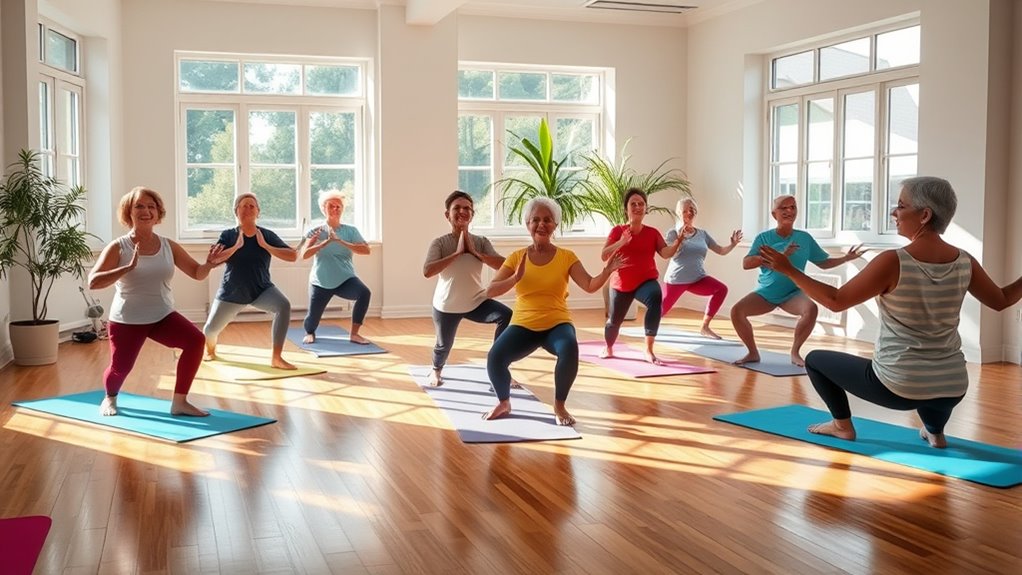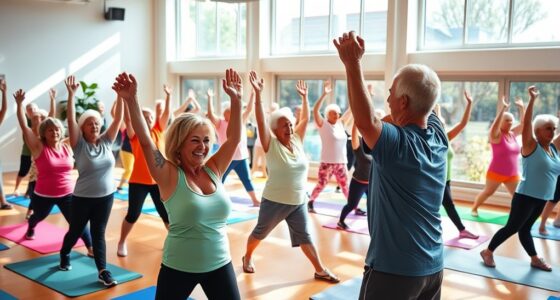Beginner yoga classes for seniors are a wonderful way to enhance your flexibility, balance, and overall well-being. You’ll fall in love with gentle movements that promote relaxation while building strength and stability. By creating a comfortable practice space and focusing on breath awareness, you can connect more deeply with your body and intentions. Plus, joining a community of like-minded individuals adds to the joy. Stick around to explore how these elements can enrich your yoga journey.
Key Takeaways
- Look for classes specifically designed for seniors, focusing on gentle movements to enhance flexibility, balance, and overall well-being.
- Seek out instructors who emphasize breath awareness and mindfulness to create a calming and supportive atmosphere.
- Choose classes that incorporate props like mats, blankets, and cushions for added comfort and safety during practice.
- Consider group classes to foster a sense of community, providing motivation and encouragement from like-minded participants.
- Explore local resources or online platforms offering beginner-friendly yoga sessions tailored for seniors, making it accessible and enjoyable.
The Benefits of Gentle Yoga for Seniors

As you explore gentle yoga, you’ll discover its numerous benefits tailored specifically for seniors. This practice helps you feel good by promoting flexibility and mobility, which is vital for maintaining your range of motion and reducing stiffness in your joints. Incorporating regular physical activity into your routine can significantly enhance your overall health. Engaging in gentle yoga can also help you align with your desired realities, allowing you to manifest a more vibrant life. Additionally, the use of essential oils during your practice can enhance relaxation and create a calming environment.
Every step you take in gentle yoga enhances your balance and coordination, considerably lowering your risk of falls. Research indicates that regular participation in low-impact exercises can improve your stability and strength, further decreasing fall risk. You’ll also find that the emphasis on breath awareness fosters relaxation, leading to lower blood pressure and improved cardiovascular health.
In addition, engaging in gentle yoga can boost your mental well-being, alleviating feelings of anxiety and depression. As you participate regularly, you’ll enjoy the social interaction that combats loneliness, reminding you to always listen to your body and honor its needs. Incorporating gentle yoga into your routine can also support long-term financial planning for assisted living needs by fostering a healthier lifestyle that may reduce medical costs over time.
Creating a Comfortable Practice Space
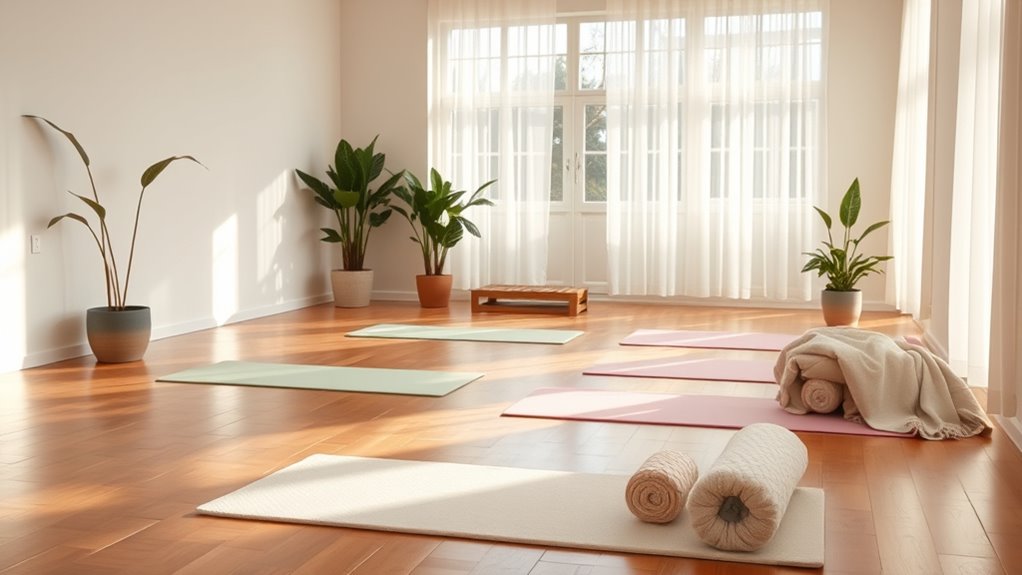
Creating a comfortable practice space is essential for enjoying a fulfilling yoga experience.
By setting up your environment thoughtfully, you can enhance relaxation and focus during your sessions.
Here are four tips to help you create an ideal space:
- Choose a Quiet Location: Select a spot with enough space for gentle movements, free from noise and distractions.
- Use Props: Incorporate yoga mats, blankets, or cushions for support, ensuring your spine stays lifted and comfortable. Additionally, consider using an air purifier with HEPA filtration to ensure clean air while you practice. Clean air can significantly improve respiratory health during physical activities. Regular cleaning of the air purifier will help maintain its effectiveness and provide optimal performance. Keeping the air in your practice area fresh can also enhance your overall comfort levels.
- Regulate Temperature: Keep the room at a comfortable temperature, balancing warmth and coolness for a soothing atmosphere.
- Consider Lighting: Opt for natural light or soft lamps to create a warm ambiance that fosters peace and mindfulness during practice.
Additionally, ensuring good air quality in your practice space can further promote relaxation and enhance your yoga experience.
These elements will help you create a serene environment for your yoga journey.
Understanding Breath Awareness

In yoga, breath awareness is key to enhancing your practice and overall well-being. By focusing on your breathing, you can release tension and deepen your connection to each movement. Studies show that pet therapy can also promote relaxation and emotional well-being, which complements your yoga practice. Additionally, practicing mindfulness through adaptogenic properties can help you stay present and reduce stress during your sessions. Let’s explore some effective techniques for deep breathing that will help you cultivate this essential skill. Incorporating natural remedies such as herbal teas can further support relaxation and enhance your breathing experience. Furthermore, utilizing essential oils with natural antibacterial properties can create a calming atmosphere that enhances your overall practice, as certain oils like lavender have been shown to promote relaxation and reduce stress levels.
Importance of Breath Awareness
Breath awareness is crucial in yoga, offering a pathway to mindfulness and relaxation that benefits seniors immensely.
By focusing on your breath, you can reveal numerous advantages:
- Stress Reduction: Conscious breath control lowers stress and anxiety levels, enhancing your overall well-being. Additionally, incorporating essential oils like eucalyptus oil can further promote relaxation during your practice. Engaging in AI-driven mindfulness techniques can also provide valuable insights into your stress management strategies. Practicing breath awareness can also be complemented by mindful juicing to enhance your overall wellness. Furthermore, integrating creative storytelling into your practice can help you connect with your emotions and experiences more deeply.
- Enhanced Lung Capacity: Observing and deepening your breath improves oxygenation, supporting better physical health and energy.
- Mind-Body Connection: Integrating breath awareness fosters a deeper connection between your mind and body, promoting self-awareness and emotional regulation.
- Improved Posture: A breath-centered practice encourages mindful movements and alignment during poses, leading to better posture.
Incorporating breath awareness aligns with the principles of critical periods identified in the psychology of development, as consistent practice can accelerate your growth in yoga.
Emphasizing breath awareness in your yoga journey can create a transformative experience, helping you feel more balanced and centered.
Techniques for Deep Breathing
Several effective techniques can help you master deep breathing, enhancing your yoga practice and overall well-being.
Start with diaphragmatic breathing; place one hand on your belly and inhale deeply through your nose, allowing your belly to expand. Exhale slowly, feeling your belly fall. This encourages better lung function and digestion.
Next, focus on your breath’s rhythm during poses; this keeps you grounded and boosts mindfulness. Engaging in playful communication, such as seniors texting humor, can also bring lightness to your practice.
It’s also beneficial to practice breath awareness throughout the day, which lowers stress and promotes clarity. Engaging in mindfulness through unplugging from technology can further enhance your connection with your breath.
Incorporating these techniques regularly can elevate your energy levels and help manage chronic pain.
Setting Personal Intentions

Setting personal intentions can transform your yoga practice by giving you a clear focus and purpose.
As you connect your breath with these intentions, you’ll deepen your awareness of your body and emotions.
This personalized approach not only enhances your experience but also fosters a sense of community with fellow participants.
Importance of Intentions
Intentions play an essential role in enhancing your yoga practice, especially for seniors seeking clarity and purpose. By setting personal intentions, you can create a focused mindset that fosters mindfulness and emotional well-being.
Here are some key benefits of establishing intentions in your practice:
- Clarity: Intentions help clarify your goals, making your yoga sessions more directed.
- Mindfulness: Research shows that intention setting reduces stress, promoting a sense of calm.
- Guidance: Your intentions serve as a guiding principle, keeping you centered during challenges.
- Empowerment: Regularly reflecting on your intentions fosters self-discovery and encourages active engagement in your health.
Connecting Breath and Intentions
As you begin your yoga practice, connecting your breath with personal intentions can enrich your experience and deepen your focus. Setting an intention helps create a mindful atmosphere, allowing you to stay present. Place your hands at your heart center as you state your intention, enhancing your emotional connection. Throughout your practice, return to your breath as a reminder to align with this intention, fostering calm and clarity. Research shows that this approach leads to improved well-being, especially for seniors seeking relaxation and balance.
| Breath Awareness | Personal Intentions |
|---|---|
| Deepens mindfulness | Creates focused mindset |
| Enhances emotional well-being | Encourages presence |
| Promotes calmness | Fosters clarity |
| Improves satisfaction | Supports relaxation |
Personalizing Your Practice
When you commence your yoga journey, personalizing your practice by establishing a clear intention can greatly enhance your experience.
Setting an intention helps create a focused mindset, aligning your practice with your goals and desires. Here are some ways to personalize your practice:
- Identify Your Goals: Reflect on what you hope to achieve—be it relaxation, strength, or flexibility.
- Connect with Breath: Place your hands at your heart center to deepen your mindfulness as you breathe.
- Revisit Your Intention: During challenging poses, return to your intention to maintain motivation and focus.
- Evaluate Your Experience: After your practice, assess how your intention influenced your physical and mental well-being.
Incorporating these steps can lead to greater satisfaction in your yoga journey.
Exploring Gentle Movements

Embrace gentle movements in yoga to enhance your flexibility and reduce stiffness, making it easier to maintain mobility as you age.
Focus on simple exercises like arm reaches and spinal rounds, which are perfect for seniors. Incorporating gentle twists, whether seated or standing, promotes spinal health and aids digestion.
Don’t hesitate to use props like blankets or towels; they provide extra support and help you achieve proper alignment. Practicing slow, mindful movements cultivates body awareness and improves balance, greatly reducing your risk of falls.
Additionally, connecting your movements with your breath encourages relaxation and stress reduction, fostering a sense of overall well-being.
As you explore these gentle movements, you’ll find joy and comfort in your practice.
The Importance of Modifications
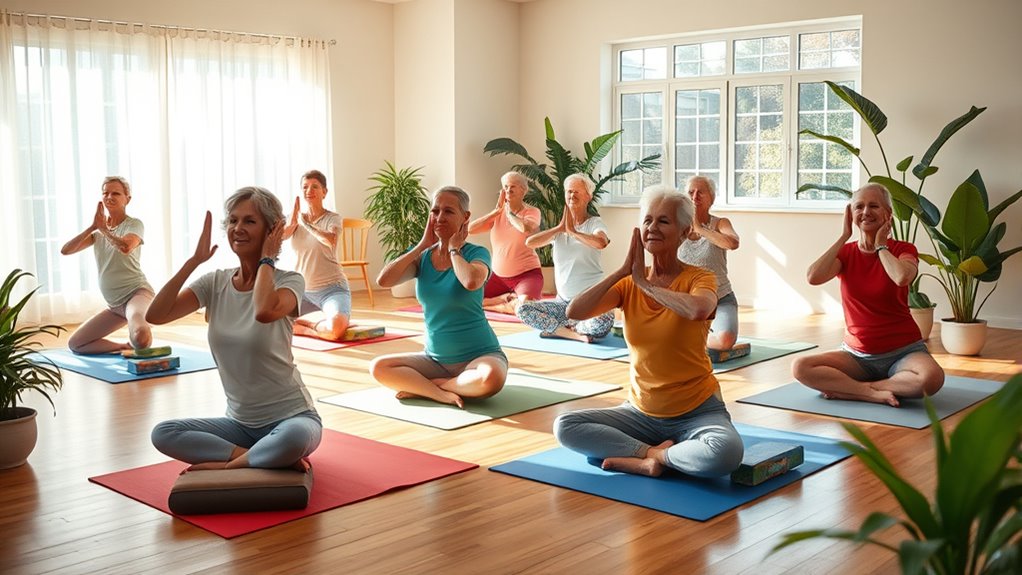
Modifications play an essential role in making yoga accessible for seniors, allowing you to practice safely while accommodating your unique flexibility and strength levels.
Embracing these modifications can greatly enhance your yoga experience. Here are some key benefits:
- Utilizing props like blankets, chairs, and straps provides comfort and support.
- Focusing on breath awareness helps maintain a connection to your body, reducing the risk of strain.
- Incorporating modified poses encourages participation, fostering a sense of community and improving both physical and mental well-being.
- Practicing regularly enhances balance, coordination, and confidence, promoting a more active and independent lifestyle.
Standing Poses for Strength and Stability

Standing poses are fundamental for building strength and stability, especially for seniors looking to enhance their physical abilities. Poses like Mountain Pose and Triangle Pose engage your core and lower body, helping you maintain balance in daily activities.
They promote better posture and alignment by emphasizing your connection to the ground, reducing the risk of falls. Gentle movements, such as bending and straightening your knees, improve joint flexibility and mobility, which are essential for maintaining independence as you age.
Practicing these poses also encourages mindful breathing, increasing oxygen flow to your muscles and enhancing overall vigor.
Connecting Mindfulness With Movement
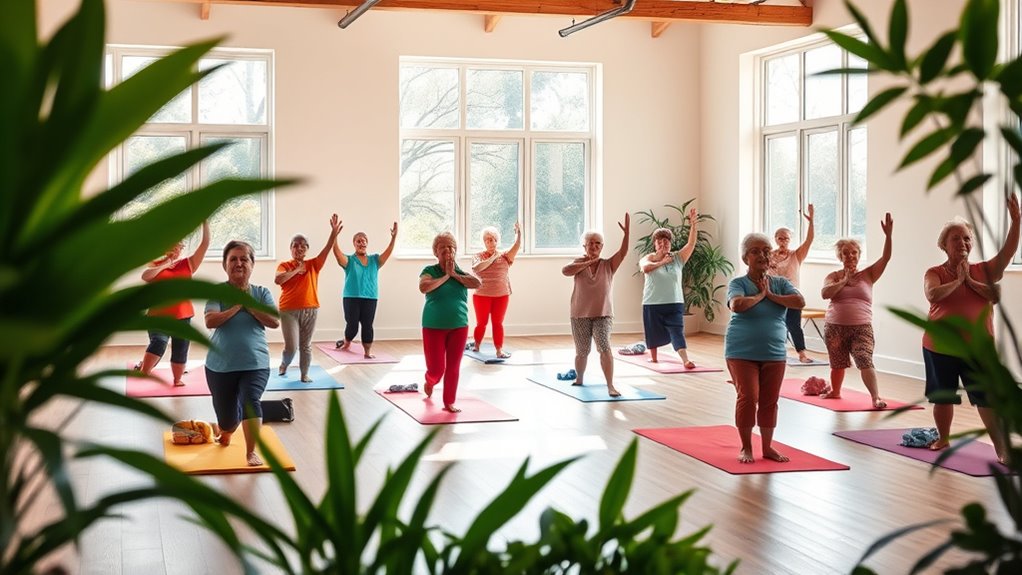
While you flow through your yoga practice, connecting mindfulness with movement can greatly enhance your experience. This connection promotes relaxation and increases body awareness, especially beneficial for seniors.
To cultivate mindfulness in your practice, consider these key elements:
Cultivating mindfulness in yoga involves focusing on breath, setting intentions, incorporating gentle movements, and embracing the present moment.
- Focus on Your Breath: Allow your breath to guide your movements, creating a natural rhythm.
- Set a Personal Intention: Begin each session with an intention, reinforcing your mind-body connection.
- Incorporate Gentle Movements: Use twists and stretches to engage your body safely and comfortably.
- Embrace the Present Moment: Stay aware of your body’s sensations, fostering mental clarity and emotional well-being.
Cultivating Community and Connection

In beginner yoga classes, you’ll find a welcoming space where you can build social bonds with others on a similar wellness journey.
Sharing experiences and challenges fosters trust and camaraderie, making each class feel like a supportive community.
Engaging in group activities not only enhances your practice but also strengthens those connections, enriching your overall experience.
Building Social Bonds
Many seniors find that participating in beginner yoga classes offers more than just physical benefits; it also creates a vibrant space for building social bonds.
In these supportive environments, you connect with others who share similar experiences and challenges. The group setting fosters interactions, enhancing your sense of belonging.
Here are some key benefits of building social bonds through yoga:
- Enhanced Motivation: You’re more likely to attend classes regularly alongside friends.
- Emotional Well-Being: Strong social connections can reduce feelings of isolation.
- Shared Mindfulness: Engaging in discussions about your experiences deepens connections.
- Community Events: Many studios host gatherings, creating further opportunities to form lasting relationships.
These elements come together, enriching your yoga journey and life.
Shared Wellness Journey
Participating in beginner yoga classes creates a unique opportunity for you to commence a shared wellness journey alongside others who understand your aspirations and challenges.
In these group sessions, you’ll connect with fellow seniors who share similar wellness goals and experiences, fostering a strong sense of community. This connection enhances emotional well-being and helps combat feelings of isolation.
Many yoga studios offer specialized classes designed for seniors, making it easier to cultivate these important relationships. Engaging in a collective practice not only promotes accountability and motivation but also helps you stay committed to your wellness journey.
As you share this experience, you’ll form lasting friendships and enjoy the support that comes from being part of a like-minded community.
Reflecting on Your Yoga Journey

As you commence your yoga journey, reflecting on your progress can illuminate how far you’ve come, especially regarding flexibility and balance—key components for maintaining your independence as a senior.
To enhance your practice, consider these steps:
- Keep a Journal: Document your experiences and feelings to boost self-awareness and deepen your connection with your movements.
- Assess Your Goals: Regularly revisit your intentions to stay motivated and focused on personal growth in your yoga practice.
- Engage with Others: Discuss your journey with fellow practitioners or instructors for valuable insights and support.
- Celebrate Milestones: Acknowledge small achievements, like mastering a new pose, to reinforce a positive mindset and enhance your enjoyment of yoga.
Frequently Asked Questions
Which Yoga Is Best for Senior Beginners?
When you’re considering which yoga is best for senior beginners, gentle styles are a great choice.
Hatha yoga offers a slow pace and focuses on basic postures, making it accessible.
Chair yoga allows you to practice while seated, enhancing stability.
Restorative yoga uses props for support, promoting relaxation.
Incorporating breath awareness and intention setting into your practice can also help you cultivate mindfulness and improve your overall well-being.
Is 70 Too Old to Start Yoga?
No, 70 isn’t too old to start yoga!
In fact, many people your age find it incredibly beneficial. Yoga can enhance your flexibility, strength, and balance, which are essential for daily activities.
Plus, it helps alleviate common issues like arthritis and anxiety. You’ll discover that gentle movements and modifications make it accessible for everyone, regardless of experience.
Embracing yoga now can greatly improve your overall well-being and quality of life.
What Is the Best Yoga to Start With as a Beginner?
Just like the gentle flow of a serene river, starting with Hatha or restorative yoga can be your perfect entry point.
These styles focus on relaxation and balance, making them ideal for beginners. You’ll find that simple poses like Mountain and Triangle enhance your strength without overwhelming you.
Incorporating props guarantees your comfort, while breath awareness helps you stay present.
You’ll build confidence gradually, fostering a mindful practice that nurtures your overall well-being.
How Many Times a Week Should Seniors Do Yoga?
You should aim to practice yoga 2 to 3 times a week to enjoy its full benefits. Regular sessions can improve your flexibility, balance, and overall well-being.
Even practicing once a week can help reduce anxiety and increase mindfulness. Listen to your body and adjust based on how you feel; short, gentle sessions more frequently can be more effective than longer practices done less often.
Consistency is key for a healthier, happier you!
Conclusion
As you roll up your mat, take a moment to breathe in the tranquility you’ve cultivated. Picture yourself surrounded by a warm circle of friends, each sharing smiles and stories, hearts intertwined through gentle movement. You’ve embraced the strength within, discovering the joy of mindfulness. With every pose, you’ve woven threads of connection, creating a tapestry of well-being. As you step off the mat, carry this serenity with you, knowing that your yoga journey is just beginning.
